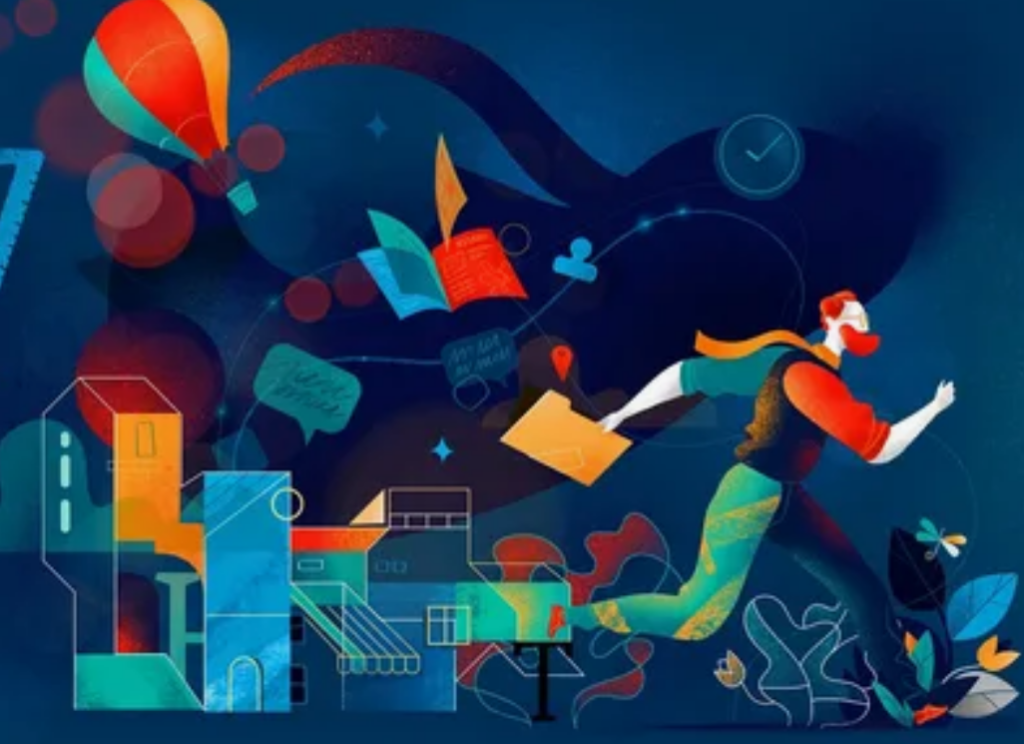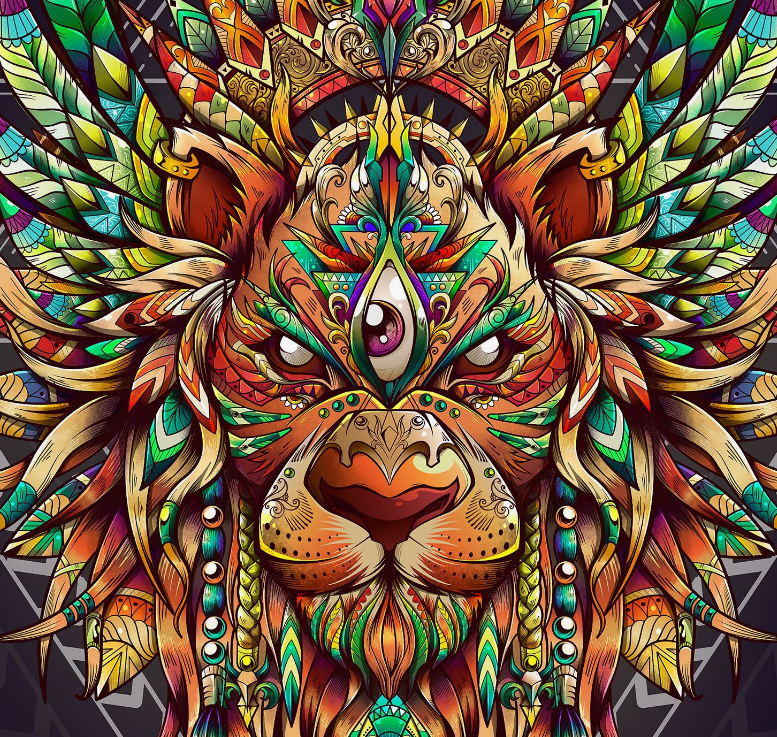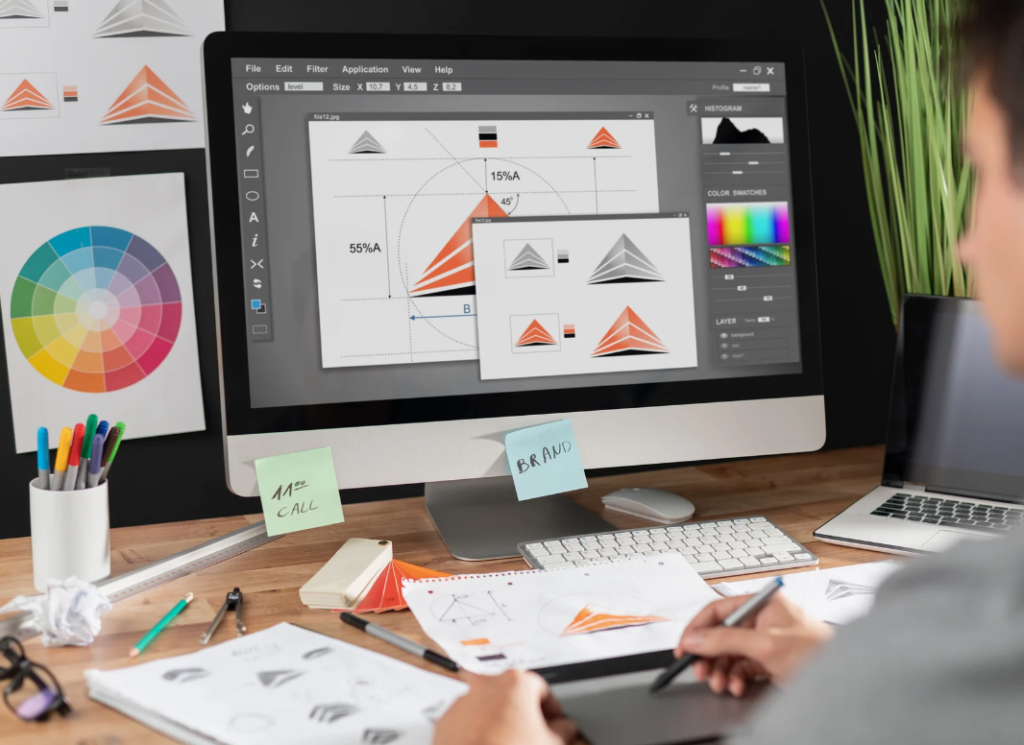Adobe Illustrator is a graphic design application used to create vector graphics, consisting of points, lines, shapes, and curves. Graphic designers utilize Illustrator for its ability to create scalable images based on mathematical formulas. Illustrator is popular among designers for its versatility and high-quality output. With its range of tools and functionalities, Adobe Illustrator is a go-to software for creating stunning visual designs across various industries. Whether you are a beginner looking to learn the basics or a seasoned professional seeking advanced techniques, Adobe Illustrator offers a comprehensive platform for all your graphic design needs.
Adobe Illustrator Graphic Design

The Evolution of Adobe Illustrator
Adobe Illustrator Graphic Design and The Evolution of Adobe Illustrator have revolutionized the world of graphic design. Adobe Illustrator is a powerful vector graphics editor developed and marketed by Adobe Inc. It has become the industry standard for creating illustrations, logos, icons, typography, and complex graphics for print, web, video, and mobile applications.
Introduction To Adobe Illustrator- Adobe Illustrator Graphic Design
Adobe Illustrator was first released in 1987 for Apple Macintosh computers, making it one of the oldest graphic design software. It allows users to create and manipulate vector graphics with precision. The software is known for its wide range of tools and features that enable designers to bring their creative ideas to life. Some key features of Adobe Illustrator include:
- Vector Graphics: Illustrator uses mathematical equations to create scalable artwork that can be resized without losing quality.
- Pen Tool: A signature tool in Illustrator for creating precise paths and shapes.
- Typography: Advanced text tools for customizing fonts, styles, and layouts.
- Effects and Filters: Various effects and filters to enhance artwork and create unique designs.
Key Milestones In Adobe Illustrator’s Development
Over the years, Adobe Illustrator has undergone significant developments and updates that have shaped its current capabilities. Some key milestones in the evolution of Adobe Illustrator include:
| Year | Development |
|---|---|
| 1987 | Initial release of Adobe Illustrator for Macintosh |
| 1990 | Introduction of the Pathfinder palette for shape operations |
| 2003 | Integration with Adobe Creative Suite |
| 2015 | Transition to a subscription-based service with Adobe Creative Cloud |
Core Features of Adobe Illustrator
Adobe Illustrator Graphic Design is a powerful software tool used by graphic designers to create stunning and professional designs. With its wide range of features and tools, Adobe Illustrator allows designers to bring their creative visions to life. In this blog post, we will explore the core features of Adobe Illustrator, including vector graphics creation, typography tools, and image trace functionality.
Vector Graphics Creation
One of the key features of Adobe Illustrator is its ability to create vector graphics. Unlike raster graphics, which are made up of pixels, vector graphics are made up of mathematical equations and can be scaled to any size without losing quality. This makes Adobe Illustrator the go-to software for creating logos, icons, and illustrations. With its powerful drawing tools and shape manipulation options, designers can easily create complex and intricate vector graphics.
Some important features for vector graphics creation in Adobe Illustrator include:
- Pen Tool: Allows users to draw and edit paths with precision.
- Shape Builder Tool: Enables users to combine and subtract shapes to create custom designs.
- Pathfinder Panel: Provides various options for combining and manipulating shapes.
- Anchor Point Tool: Allows users to manipulate anchor points and curves.
Typography Tools
Adobe Illustrator also offers a range of typography tools that allow designers to create visually appealing and professional-looking text. Whether it’s creating custom fonts, applying text effects, or arranging text in creative ways, Adobe Illustrator has the tools to bring typography to the next level. Some key typography tools in Adobe Illustrator include:
- Type Tool: Allows users to add and edit text in their designs.
- Character Panel: Provides options for adjusting font, size, spacing, and other text attributes.
- Paragraph Panel: Allows users to control the alignment, indentation, and spacing of paragraphs.
- Text Effects: Offers various effects like shadows, outlines, and gradients to enhance the appearance of text.
Image Trace Functionality
Another powerful feature of Adobe Illustrator is its image trace functionality. This feature allows designers to convert raster images into vector graphics, making it easier to edit and manipulate them. With the image trace tool, designers can automatically trace the outlines and shapes of an image and convert it into editable vector paths. This is particularly useful when working with logos or other graphics that need to be scaled without losing quality.
The image trace functionality in Adobe Illustrator offers various options for customizing the tracing process, such as adjusting the level of detail, smoothing curves, and choosing different color modes. Designers can also refine the traced paths using the available editing tools.
Designing With Adobe Illustrator
Adobe Illustrator is an essential tool for creating stunning graphic designs. With its powerful features and intuitive interface, designers can easily craft vector graphics with precision and flexibility. From creating logos to illustrations, Adobe Illustrator empowers designers to bring their creative visions to life with ease and efficiency.
Advanced Techniques In Adobe Illustrator
Adobe Illustrator Graphic Design is a powerful tool used by graphic designers to create stunning visuals and illustrations. Advanced techniques in Adobe Illustrator can help designers take their work to the next level. In this blog post, we will discuss some of the most useful advanced techniques in Adobe Illustrator, including mastering the pen tool, working with layers and masks, and using effects and filters.
Mastering The Pen Tool
The pen tool is a versatile tool that allows designers to create precise and complex shapes in Illustrator. Here are some tips to help you master the pen tool:
- Use the anchor point tool to adjust and refine anchor points
- Hold down the shift key while drawing to create straight lines
- Use the convert anchor point tool to switch between straight and curved lines
- Experiment with the different pen tool options, such as the curvature tool and the smooth tool, to achieve the desired effect
Working With Layers And Masks
Layers and masks are essential tools for organizing and manipulating objects in Illustrator. Here are some tips for working with layers and masks:
| Tip | Description |
|---|---|
| Use naming conventions | Assign descriptive names to layers and masks to make it easier to locate and organize objects |
| Group objects | Use the group function to keep related objects together and make it easier to manipulate them as a unit |
| Use clipping masks | Create a clipping mask to crop an object and reveal only a portion of it |
| Experiment with layer effects | Use layer effects, such as drop shadows and glows, to add depth and dimension to your designs |
Using Effects and Filters
Effects and filters can help designers create unique and eye-catching designs in Illustrator. Here are some tips for using effects and filters:
- Experiment with the different effects and filters to discover new ways to enhance your designs
- Combine multiple effects and filters to create complex and layered effects
- Use the appearance panel to apply effects and filters to specific objects or groups
- Adjust the settings of effects and filters to fine-tune the appearance of your designs
Integrating Adobe Illustrator With Other Tools
Adobe Illustrator is a powerful graphic design software that allows designers to create stunning visuals and illustrations. It is widely used in the industry for its versatile features and user-friendly interface. In this blog post, we will explore how Adobe Illustrator can be integrated with other tools to enhance the design workflow and collaboration process.
Collaboration With Adobe Creative Cloud
Adobe Creative Cloud is a suite of applications that includes Illustrator, Photoshop, InDesign, and more. It provides seamless integration between these tools, allowing designers to collaborate on projects easily. With Creative Cloud Libraries, designers can share assets, such as colors, graphics, and fonts, across different Adobe applications. This ensures consistency in design and saves time in searching for resources. Additionally, designers can use Adobe Stock, which is integrated with Illustrator, to access a vast collection of high-quality images and illustrations for their projects.

Here are some key benefits of collaborating with Adobe Creative Cloud:
- Streamlined workflow: Designers can switch between Illustrator and other Adobe applications seamlessly, making the design process more efficient.
- Shared assets: Creative Cloud Libraries allow designers to access and share assets across different projects, ensuring consistency in design elements.
- Real-time collaboration: Designers can collaborate with team members in real time, making it easier to share feedback and make changes on the go.
Workflow With Adobe Photoshop And Indesign
Adobe Illustrator works hand in hand with Adobe Photoshop and InDesign to create a complete design workflow. While Illustrator is primarily used for creating vector graphics and illustrations, Photoshop is ideal for editing and manipulating raster images. InDesign, on the other hand, is a layout design software used for creating print and digital publications.
Here’s how you can integrate Illustrator with Photoshop and InDesign:
| Task | Software |
|---|---|
| Create vector graphics and illustrations | Illustrator |
| Edit and manipulate raster images | Photoshop |
| Create layouts and designs for publications | InDesign |
| Export Illustrator files to Photoshop or InDesign | Illustrator |
By integrating Illustrator with Photoshop and InDesign, designers can leverage the strengths of each software to create visually stunning and professionally designed projects.
Tips and Tricks For Efficient Design Workflows
Adobe Illustrator Graphic Design and Tips and Tricks for Efficient Design Workflows provide essential techniques for enhancing your design process.
Keyboard Shortcuts For Productivity
Utilizing keyboard shortcuts in Adobe Illustrator can significantly boost your productivity. Here are some commonly used shortcuts:
- Ctrl + C: Copy
- Ctrl + V: Paste
- Ctrl + Z: Undo
- Ctrl + S: Save
Customizing Preferences For Smooth Workflow
Customizing preferences in Adobe Illustrator can help create a seamless workflow. Consider adjusting settings such as PreferenceCustomizationWorkspaceArrange panels for easy accessories & GuidesSet up grids for precisionToolsCustomize tool presets
Exploring Inspirational Adobe Illustrator Projects
Adobe Illustrator Graphic Design is a powerful tool used by industry professionals to create stunning designs. In this article, we will explore inspirational projects created using Adobe Illustrator and analyze design trends in the software.
Showcasing Creative Designs From Industry Professionals
Industry professionals have created amazing designs using Adobe Illustrator. Here are some of the most creative designs:
- A logo for a famous sports team
- A packaging design for a popular consumer brand
- An illustration for a children’s book
These designs showcase the versatility and creativity that Adobe Illustrator offers. The software allows designers to create complex designs with ease, thanks to its intuitive user interface.
Analyzing Design Trends In Adobe Illustrator
Adobe Illustrator has been used to create some of the most iconic designs in recent history. Here are some of the design trends that have emerged in recent years:
| Trend | Description |
|---|---|
| Flat design | Using simple geometric shapes and bright colors to create minimalist designs |
| Hand-drawn illustrations | Creating designs that look like they were drawn by hand, giving them a personal touch |
| 3D designs | Using Adobe Illustrator’s 3D tools to create stunning designs with depth and perspective |
These design trends show how Adobe Illustrator is constantly evolving to meet the needs of designers. By staying up-to-date on the latest trends, designers can create designs that are both innovative and visually appealing.
The Future of Adobe Illustrator In Graphic Design
Adobe Illustrator Graphic Design and The Future of Adobe Illustrator in Graphic Design…
Emerging Technologies Impacting Graphic Design
In recent years, graphic design has been significantly influenced by various emerging technologies. The introduction of artificial intelligence and machine learning has revolutionized the design process, offering advanced tools for automating repetitive tasks and generating complex designs. Additionally, virtual reality and augmented reality have opened up new avenues for interactive and immersive design experiences. Moreover, the rise of responsive design has compelled designers to create adaptable and dynamic visual content that seamlessly adapts to various devices and screen sizes. These technologies are reshaping the landscape of graphic design, presenting exciting opportunities for Adobe Illustrator users to explore innovative design possibilities.

Predictions For Adobe Illustrator’s Evolution
Looking ahead, the future of Adobe Illustrator is poised for remarkable advancements. With the ongoing integration of AI-driven features, Illustrator is expected to offer intelligent design suggestions and automated workflows that streamline the creative process. Furthermore, the software is likely to enhance its collaborative capabilities, allowing designers to work seamlessly across multiple platforms and devices. As the demand for sustainable design continues to grow, Adobe Illustrator is anticipated to introduce environmentally conscious tools and resources that promote eco-friendly design practices. These predictions underscore the potential for Adobe Illustrator to evolve into a powerful and versatile tool that empowers designers to create impactful and sustainable visual narratives.
Conclusion
Adobe Illustrator is an essential tool for graphic design, allowing for the creation of high-quality vector graphics. It provides a wide range of functionalities and tools that empower designers to bring their creative visions to life. With its versatility and user-friendly interface, Illustrator is a valuable asset for both aspiring and experienced graphic designers.

